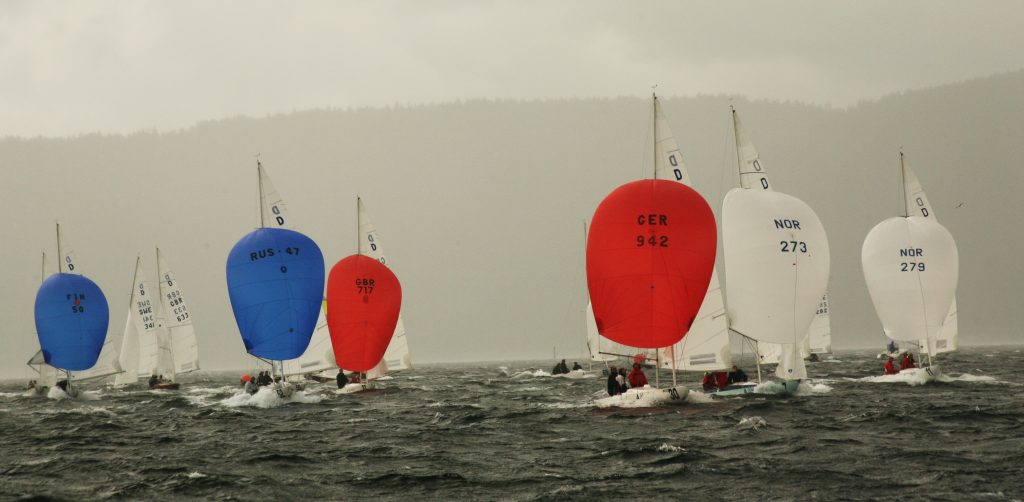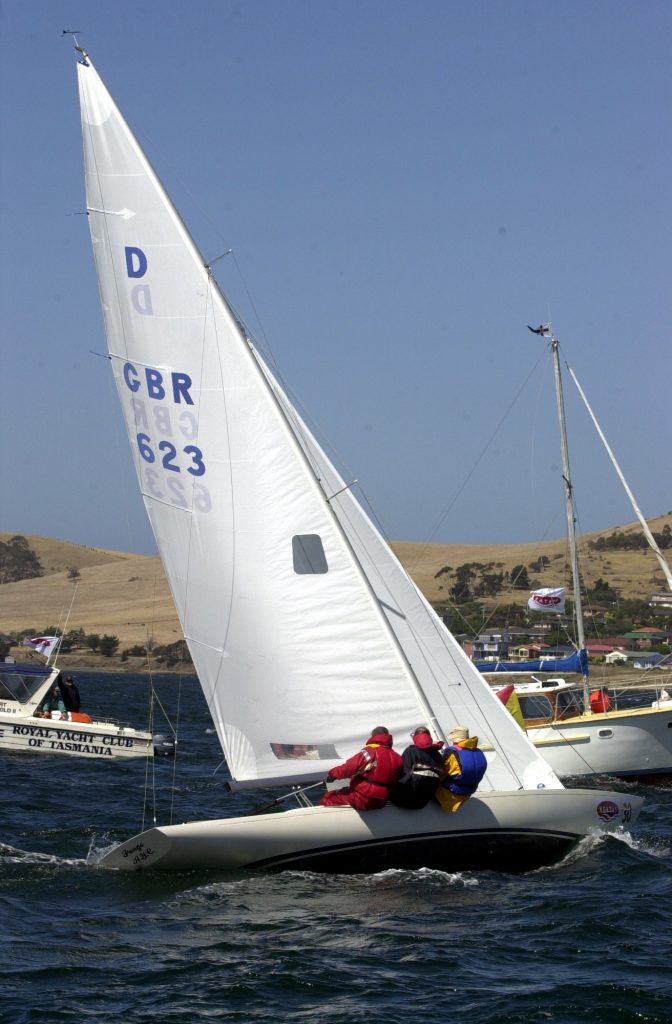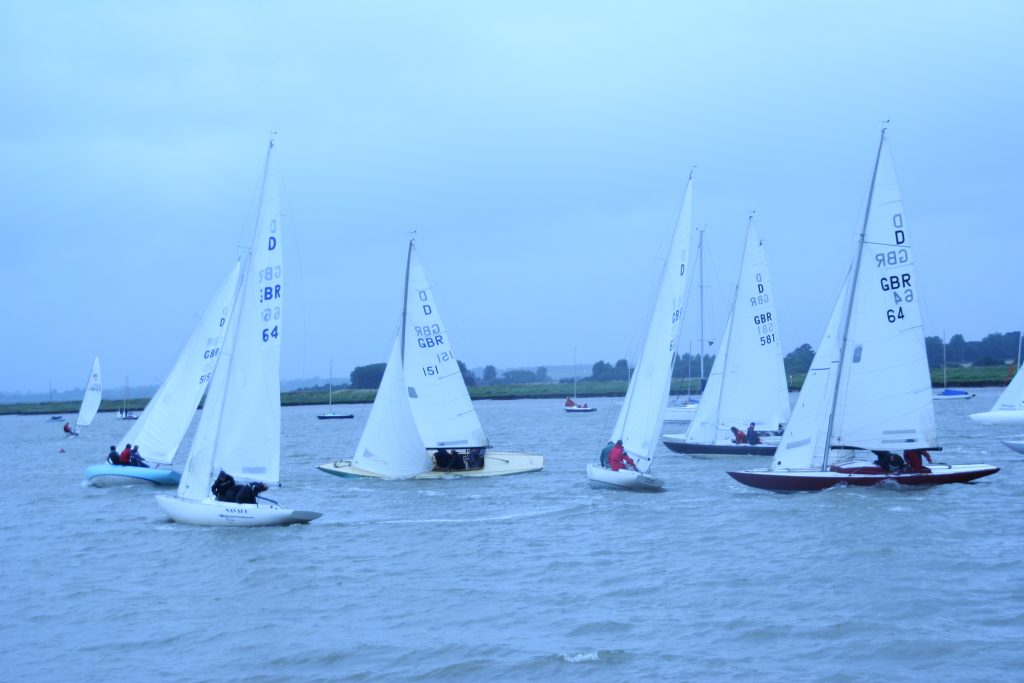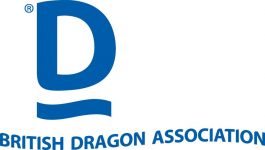It seemed absurd in 2007 to be writing this article, let alone updating it in 2020 for a further thirteen years of Dragon racing, but I continue to have doubts about how many events I will be going to in five years time, more so than in 2007 when 50 would have been a rounder number. I must either have begun Dragon sailing very young or be even older than my joints sometimes feel after a hard race. Rather than re-write the whole article I’ve added an update at the end.
At any rate, the first Dragon event I remember going to away from Aldeburgh was Burnham week in 1962. I crewed for Jack Comins, who appeared to have named the Dragon Ula after his car number plate. We began with a bang and a three way collision near the Outer Crouch mark in Force 8. Pat Dyas won all the races ridiculously easily in the new Jerboa, K374, which I still think was one of the fastest Dragons built.

After that I crewed for a while, most memorably in Meltemi for Bobby Pegna at the KDY centenary regatta at Skovshoved in 1966. There were, from memory, 120 Dragons there, as well as a great number of other classes the length of the Oresund. Mostly it blew. We weren’t very fast but it was the biggest gathering of the legends of the class that has ever taken place. It also showed me two things. The first was how a thorough rethinking of the layout, as shown in Lowell North’s Aphrodite, could really change the way to think about a Dragon. The second was how much damage you could do in a collision. The American boat Williwaw, helmed by Buddy Friedrichs who won the 1968 Gold Medal in her,was surfed into just forward of the mast. This opened her up like a can from the bow back to the mast on both sides as well as making a very large hole. Very striking. I didn’t and still don’t understand why she didn’t sink given it was blowing hard at the time.
Since then I became a helmsman and became increasingly peripatetic. Our first real foray into the truly international was another Gold Cup in 1984 at Skovshoved. We went there with Polly, a 1966 Borresen boat, which was wooden and by then in her nineteenth season. We ultimately finished twelth. The most striking moment came in the practice race when we sailed most of the first beat in company with a Dane, D237, going as fast as him most of the time. We didn’t know him , but he turned out to be Valdemar Bandolowski, who won the Gold Cup. We had arrived.

Most of the events that we have been to since then have obviously been in Western Europe. However, the furthest west has been Martinique, the furthest south Hobart, north Hanko in Finland, though Marstrand in December seemed to be in the Arctic Circle and east(in Europe) Estonia. There have been many memorable occasions. The best was finishing third in the Gold Cup in Dublin with Mary and Mike Hayles. We were easily the best genuinely amateur boat and really irritated the Australians by having a female crew. They finished fourth! Other moments have been race wins in the Gold Cup, the Worlds and the English Speaking Union Trophy(what happened to it? It was huge!).It was particularly pleasant to lead Poul_Richard all the way round the course in a Gold Cup race in Torquay and then retire to the Carved Angel in Dartmouth which we had presciently booked for dinner beforehand. Unfortunately Poul-Richard has very deservedly had by far the advantage over us over the years.
The most regular crew have been Mary, Mike Hayles and Michael Gifford, though many others have come with us at various times. Some, such as James Mehew, have even gone on to buy their own Dragon. They have all shown considerable loyalty to an often over-tense, and therefore difficult helmsman.
The venues have ranged from the very cold(Marstrand in December and Lowestoft and Levington in May) to the hot(Hobart, Martinique and Marstrand in July). They have also been very fair, as at Hanko for the 2007 Europeans or fascinatingly difficult as at Hobart for the Worlds in 2003. Is it a good idea to park a 4,000 foot high mountain just to windward of the racecourse? We have seen hurricanes and tornados as at Enkhuizen, flat calms and rain as at Thun, windbends at Attersee and Thun and the most unexpected 50knot gale at Hobart. Sybaritic pleasure was high at Attersee where the Union Yacht Club runs a subversive week long tab system. Dublin and Denmark also hold many particularly pleasant memories, though some have been blurred at the time.

So what has changed? The boats are the most obvious. GRP has replaced wood, despite a revival in the form of cold-moulded boats. The speed of the hulls didn’t change, so the real effect was on cost and consistency of hulls. However, the changes in the rig and fittings have been much more significant. I believe that the wooden masts de-powered the rig however much one tried to prevent this. As a result crew weight didn’t seem to be so important. They also tended to break at the main spreader, something one never sees now. Metal masts have made for a much more powerful rig and the ability to put much greater loads on them, especially with the runners. Everything has become more sophisticated, much to the joy of some, not all, of my crew. You can now adjust everything. The only problem is that you may not know what to do. In the 1960s there was much less to play with and what there was was hard to adjust.
Other changes: I have owned three really aged lorries in the past to move Dragons around. I really don’t want to do so again. I am really grateful to Harbeck, Kufer, RM et al. for making life easier. I only hope that regulation doesn’t take us back to the past. We have mostly got richer over the last forty five years though we may currently be reversing the trend. Gone are the days of sleeping in the Dragon on the lorry in transit, or on the spinnakers. I think I will leave that to others if it threatens to reappear.
The Dragon has been kind to me. As for many, the combination of appearance, internationalism and the ability to test oneself against the best has been compelling. We need to make sure that these qualities are not lost.
Postscript 2007-2020
Since 2007 I have owned Basilisk in partnership with Mike Hayles. Until 2012 we also owned Nereid, a 1998 Borresen boat, which we sailed away from home while Basilisk stayed in Aldeburgh. Thereafter Mike sailed Naiad internationally and I sailed Basilisk away from Aldeburgh while we shared her in Aldeburgh.
There have been several memorable moments. The Europeans in Oslo in 2008 contributed the best Dragon party I have ever been to, on an island in Oslo Fjord as well as the greatest use of fuel to tow us to the racecourse. Not so green Norway! We won the first ever Gold Cup Corinthian Trophy in Marstrand in 2010, despite only finishing seventeenth overall. We set a trend there, now copied by several top crews, by sailing with four crew to the surprise of Vincent Hoesch and Michael Lipp, moored next to us. As Basilisk got older she won two Vintage Championships in Edinburgh and Aldeburgh as well as several Aldeburgh Regattas. The most memorable near-miss came when crewing for my daughter Frances in the Irish Nationals in Dun Laoghaire when we so nearly won her first ever race helming a Dragon.
Away from the UK, France and Ireland have been the most visited and the hospitality has always been fantastic. Ireland has these amazing 1840s clubhouses in Dun Laoghaire and France has food, wine and climate. It does help to speak French and Gaelic isn’t required in Dun Laoghaire. The support from friends to enable us to leave boats, trailers, cars in various logistically useful places has also been great.
The greatest change in the class has been the enormous growth in the number of professional sailors in the class. I confess to mixed feelings about this. They have helped to raise the standard and provide a yardstick for achievement. I have sailed with (unpaid) professional friends, usually sailmakers, and very much enjoyed it. However, they do restrict the opportunities for keen but inexperienced amateurs to learn as crew, and possibly later as helmsmen and they do expect the amateurs to do most of the heavy lifting of class administration.
Forget the minor gripes. The last thirteen years have been an unexpectedly long and enjoyable coda, which is still unfinished. 2021 may yet see us participating in the events we had planned to go to in 2020. However, any further postscripts will probably be shorter and be written sooner.
–Patrick Gifford 2020
